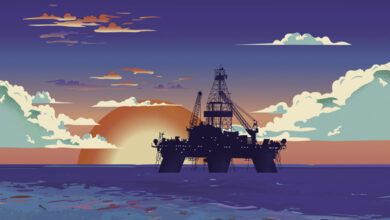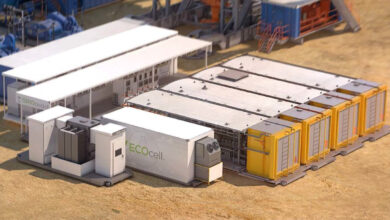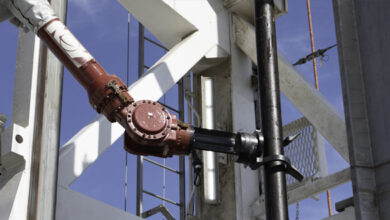By Jerry Greenberg, contributing editor
The disparity between the US Gulf of Mexico Shelf and deepwater rig markets continues to widen. Earlier this year, the jackup market reached its lowest level in 33 years, according to ODS-Petrodata figures, and slid downward from that point. Drilling contractors continued their exodus from the Gulf whenever possible, moving jackups to more lucrative areas. Despite a slowdown in some jackup markets, eight rigs will have mobilized from the Gulf by the end of July.
As far as the deepwater Gulf, most people consider it a growth market. As many as 17 newbuild deepwater rigs are scheduled to enter the region by the end of 2010. More deepwater rigs could mobilize there for a few wells, then mobilize back to other markets during this period.
Meantime, companies continue their business strategies that take them to opposite sides of the market. One operator is successful with its shallow water deep gas drilling prospects. One engineering company is looking toward the deepwater market to enable operators to drill top-hole sections more efficiently with a riserless mud recovery system.
TUMBLING JACKUP MARKET
Last January, the number of jackup rigs contracted in the US Gulf had fallen to 45, the lowest level since September 1976. By September 2008, due to Hurricane Ike, only 30 jackups were working. But if you think that the working jackup rig count could fall to that level only because of a weather event, think again.
By March 2009, the number of jackups working in the Gulf had fallen to 31, translating into a 41% utilization rate. This was due to market conditions, primarily low natural gas prices exacerbated by the lack of credit and funds for most of the independents that operate on the Shelf.
“You could ascribe almost equal weight to (low) gas prices as well as a lack of financing for smaller E&P companies to finance drilling programs,” said Ian MacPherson, an analyst with Simmons & Company International.
John Rynd, president and CEO of Hercules Offshore, puts more emphasis on the tight credit market for a turnaround in E&P activity than rebounding natural gas prices. “For any semblance of a recovery in the overall US economy, you have to have liquidity in the market to stimulate demand for cars, household goods, housing, etc, that will stimulate natural gas demand, industrial gas demand,” he said.
As of April, Hercules had five cold-stacked jackups and three cold-stacked submersibles. It had a core marketed fleet of 14 rigs, 10 contracted. These figures are flexible, however, and the number of marketed rigs could go down or up as demand dictates.
Flexibility is key in this kind of market. Mr Rynd believes the number of working jackups could move below 30 due to the credit market and gas prices. The hurricane season that begins in June could throw another wrench into the works, he said, which has already resulted in lower jackup activity during the past couple of years. Air gap criteria have meant that jackups are unable to work at their designed water-depth capability, not to mention increased operator risk, evacuation downtime, well and/or platform damage, etc.
Several drilling contractors already have cold-stacked jackups, and additional units could get cold-stacked if the market continues the way it has. For example, Pride International cold-stacked two jackups in February, bringing its total cold-stacked units to eight.
“In this kind of market, we are not going to warm-stack rigs,” said Randy Stilley, president and CEO of Seahawk, the new company that will spin off most of Pride’s jackups and operate as a division of that company. “We are either going to have them available for work, or we are going to cold-stack them.”
As of early April, Pride was continuing to market and operate six jackups in the Gulf, but Mr Stilley noted that if there continues to be a drop-off in activity, the company would consider stacking additional rigs.
He said that most customers have drilling programs that will extend through much of this year but at lower activity levels than originally planned. He too fears that the number of working jackups could fall even further.
“If we see natural gas prices fall further this summer, we could see (jackup) demand drop into the mid-20 level (in terms of rigs working).”
However, he predicted that “this year is going to be pretty ugly for natural gas prices. I don’t see any likelihood of recovery until the fourth quarter at best.”
Diamond Offshore also could cold-stack some of its jackups if the market continues to weaken. The company was operating six jackups in the Gulf last April, including four mat-supported rigs and two independent-leg cantilevers units. “There is not a big clamor for (the mat-supported) rigs,” said Les Van Dyke, director of investor relations for Diamond. “If the market doesn’t improve, it’s possible that (the mat-supported rigs) could wind up stacked, and it’s possible that we could cold-stack them rather than warm-stack them.”
It’s possible that the US Gulf could strengthen a bit just on the fact that contractors still are moving them out of the market. Eight jackups were scheduled to mobilize out by the end of July, mostly south to Mexico but also to Canada and Egypt. These include four ENSCO International rigs, three Rowan Companies jackups and one Diamond unit. Additionally, Diamond is selling its Ocean Tower jackup, which was damaged during Hurricane Ike, and will be used as an accommodation unit.
JACKUP DAYRATES
Jackup dayrates have fallen along with utilization rates. Several of Diamond’s jackups were receiving rates above $70,000 in early April. Several of Pride’s jackups were receiving between $55,000 and $65,000, down from $70,000-$80,000 during the third and fourth quarters of 2008.
In early April, Hercules saw rates ranging generally between the high $40,000s and the mid-$50,000s, with some in the mid-$60,000s to as high as the mid-$80,000s. But Mr Rynd said the company has seen certain rates decline 30%-50% from Q4 2008. The Hercules 173 and the 120, both mat-supported cantilever units, were contracted to Chevron in the low-$50,000s to the end of March 2009. They received an extension to the end of May at a rate in the mid-$30,000s.
Each of the three contractors mentioned above said they were not averse to cold-stacking additional jackups should demand falls to a cash break-even dayrate. Although each contractor had a different threshold, each also noted that the market is not near that level yet.
“We are not going to work rigs where we cannot make a fairly reasonable profit,” Mr Stilley said. “If we get close to cash cost, we will probably stack it.”
Mr Rynd agreed: “We are not believers in working at cash break-even.” When asked how close his dayrates are to that level, he replied, “We are not there yet, and cash break-even is a misnomer. Cash break-even assumes a risk-neutral event, and our business is not risk neutral. The capital cost to repair a piece of drilling equipment that may be damaged, fulfilling our obligation, drilling a well can more than wipe away any cash profit we may have gained for working at cash break-even.”
Mr Van Dyke did not mention a price but said, “We are going to maintain some discipline, and, as some of the other (drilling contractors) have done, we might elect to stack some equipment, whether it is warm-stacked or cold-stacked, in order to help tighten the market.”
DEEP GAS PROJECTS
Despite a weak Shelf rig market due to low natural gas prices and the tight credit market, McMoRan Exploration Co continues to be active as a result of its strategy to target deep- and ultra-deep gas plays. The company’s exploration strategy, which it calls the deeper pool concept, involves exploring prospects that lie below shallower intervals on the Deep Miocene geologic trend that have had significant past production.
A significant advantage is that, in most cases, infrastructure already is available, allowing discoveries to be brought on line quickly and at substantially lower development costs than discoveries in previously unexplored areas. The company believes that its techniques for identifying reservoirs below 15,000 ft – using structural geology augmented by 3D data – will enable it to identify and exploit additional deeper pool prospects.
The operator’s deep gas plays are in the shallow waters of the Gulf and onshore south Louisiana, with reserve targets of several Bcf to about 1 Tcf potential in wells ranging in depth from 15,000-25,000 ft. Its ultra-deep Shelf gas plays lie offshore in about 100 ft of water and have a reserve potential of more than 1 Tcf from wells ranging in depth from 25,000-35,000 ft. In both cases, nearby existing infrastructure is key to bringing the gas on line quickly. Ultra-deep gas discoveries can take about 18 months to commence production due to more complex completions as a result of higher pressures and temperatures, compared with deep gas prospects.
McMoRan’s Ammazzo deep gas exploratory prospect in 25 ft of water commenced drilling in November 2008 towards a proposed TD of 24,500 ft and is targeting one of the largest undrilled deep structures below 15,000 ft. This prospect is located on the southern portion of the structural ridge extending from the Flatrock and JB Mountain discoveries (located about 16 and 11 miles north-northwest, respectively), where the company successfully drilled to productive sands in the Middle Miocene. McMoRan was high bidder on South Marsh Island Block 256, which is a southern offset to the Ammazzo prospect, at the March 2009 MMS Lease Sale 208. The Rowan Mississippi is drilling the well.
The Cordage deep gas exploratory prospect commenced drilling last March toward a proposed TD of 19,500 ft. The Cordage prospect, which is located in 50 ft of water on West Cameron Block 207, is targeting sands in the Middle Miocene. The submersible Noble Joe Alford is drilling the prospect.
Additionally, McMoRan and its partners are engaged in engineering plans for the completion and production test of the South Timbalier Block 168 No. 1 ultra-deep exploratory well (formerly known as Blackbeard West No. 1). Drilled to a TD of 32,997 ft in October 2008, it is the deepest well ever drilled below the mud line in the Gulf of Mexico, according to the company. Logs indicated four potential hydrocarbon-bearing zones below 30,067 ft that require further evaluation.
The well has been temporarily abandoned while additional drilling opportunities on the flanks of this structure are reviewed. The block is located in 70 ft of water.
In addition to the above wells, McMoRan is using inland water drill barges in South Marsh Island Block 217 in its Flatrock discovery with Coastal Drilling’s Coastal 22, and on its Blueberry Hill prospect on Louisiana State Lease #340 with Parker Drilling’s Rig 76B.
DEEPWATER GULF
The Gulf deepwater is considered a growth market. Not only are all of the available semisubmersibles and drillships in the Gulf contracted and working, but additional newbuilds will enter over the next couple of years.
Eight deepwater rigs under construction are scheduled to mobilize to the Gulf during 2009 (four semisubmersibles and four drillships). Nine more newbuild floaters (three semis and six drillships) are set to arrive during 2010. The first of these, Transocean’s Discoverer Clear Leader, is already en route from the Daewoo Shipbuilding Marine Engineering (DSME) shipyard in South Korea for a contract with Chevron.
Some of the existing, and many of the newbuild, deepwater rigs are commanding $500,000 rates and higher. These rates perhaps sounded like bargains when oil prices were above $100/bbl, but not so much with $50 oil. Still, deepwater plays are such long-term projects that most operators don’t seem too concerned about the high rig costs – though they may be trying to lower other associated spread costs.
“Obviously operators are paying attention to their costs,” Mr Van Dyke said, “but they are not all running in to say we want to renegotiate any more than we did when prices went up.
“The Ocean Endeavor is working for less than $300,000 per day because we contracted it early in the cycle,” he continued. “We didn’t go to the operator and say the rate for these rigs is now $500,000 and we want it now, and they don’t do it on their side.”
This doesn’t mean there won’t be an operator who gets into a bind from time to time and might need to renegotiate a contract. In the past, drilling contractors were occasionally willing to trade additional contract term for a lower rate. “We would want to work it out in terms of dollars to be at least equal to or better than would have been otherwise,” Mr Van Dyke noted.
“You are probably going to see big reductions on new contracts,” said Allen Brooks, managing director for Parks Paton Hoepfl & Brown, “but it will all be tied to how much pressure the oil companies are under. I think you have to assume that all avenues of reducing costs are going to be explored.
“What we’ve seen is that operators run out of money, and that impacts rig contracts.”
RISERLESS MUD RETURN
Despite lower oil prices, or perhaps because of it, one company is working to make drilling more efficient and less costly. Norwegian-based AGR Drilling Services, which offers a riserless mud recovery (RMR) system for top hole sections in deepwater wells, recently was contracted by StatoilHydro for a feasibility study to investigate options for extending the RMR technology to 3,000 m (9,800 ft) operating depth in the Gulf of Mexico.
“The system has been used in water depths up to 4,800 ft,” said John Cohen, regional manager Americas, drilling services, for AGR in Houston. “RMR is an enabling technology that allows contractors and oil companies to exploit fields that have top hole hazards that are either very costly or prevent drilling in certain areas.
“The feasibility study that StatoilHydro has funded is for AGR to look at certain aspects of the system and explore what it would take to move into deeper waters.”
“To drill top holes in deep waters in the Gulf of Mexico is a great challenge,” said Steiner Strom, project leader R&D IOR. “A positive outcome of the feasibility study will be a major step forward in the context of deepwater drilling to become safer, more environmentally friendly and drilling at a lower risk.”
RMR, a dual-gradient drilling technology, can reduce drilling fluid and cement volumes, enable the use of engineered fluid systems and extend casing depths to drill past trouble zones such as shallow water flows, shallow gas hazards, and sloughing/shifting/water sensitive formations. In addition to extending casing points, RMR has the potential to eliminate one top hole casing string while improving wellbore stability. It has been used on wells drilled by jackups and is available for drilling from fixed platforms.
The RMR system includes all of the necessary controls on the drill floor for the operation of the system components. The pump module is electrically powered via an umbilical. An umbilical winch is used for lowering the pumping equipment to the seafloor, which includes a suction module that can be installed on a template or spud base with either an open or closed top (the system allows for mounting a rotating control device subsea). The suction module can be lowered via drillstring or a winch, or it can be deployed on the jet and drill-ahead assembly common in many areas.
A hose is connected to the suction module for transport of fluids and cuttings to the pump module, which in turn pumps the fluids and cuttings by a return hose to the surface. The return hose is specially designed for RMR operations and is run in sections with a quick release for each hose section. In deepwater, steel tubulars, usually casing, are used for the mud return line.
Among RMR’s benefits are the circulation and re-use of drilling fluid, increased operations predictability and lower overall cost, rapid and accurate kick detection and limited emission of drilling fluid and cuttings. RMR technology increases the probability of reaching planned casing setting depths with limited amounts of drilling fluid and allows for the collection of used drilling fluid and cuttings from the seabed and return to the rig, enabling the use of more expensive engineered fluids. The reuse of the drilling fluid also removes reliance on logistics to supply additional drilling fluid during drilling of the top hole section. Additionally, it enables precise volume monitoring to be implemented on the top hole section. In several wells, operators have eliminated the use of 20-in. conductors and successfully reached a setting depth for 13 5/8-in. casing down to more than 7,700 ft.




